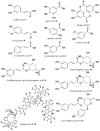Berry Leaves: An Alternative Source of Bioactive Natural Products of Nutritional and Medicinal Value
- PMID: 27258314
- PMCID: PMC4931538
- DOI: 10.3390/antiox5020017
Berry Leaves: An Alternative Source of Bioactive Natural Products of Nutritional and Medicinal Value
Abstract
Berry fruits are recognized, worldwide, as "superfoods" due to the high content of bioactive natural products and the health benefits deriving from their consumption. Berry leaves are byproducts of berry cultivation; their traditional therapeutic use against several diseases, such as the common cold, inflammation, diabetes, and ocular dysfunction, has been almost forgotten nowadays. Nevertheless, the scientific interest regarding the leaf composition and beneficial properties grows, documenting that berry leaves may be considered an alternative source of bioactives. The main bioactive compounds in berry leaves are similar as in berry fruits, i.e., phenolic acids and esters, flavonols, anthocyanins, and procyanidins. The leaves are one of the richest sources of chlorogenic acid. In various studies, these secondary metabolites have demonstrated antioxidant, anti-inflammatory, cardioprotective, and neuroprotective properties. This review focuses on the phytochemical composition of the leaves of the commonest berry species, i.e., blackcurrant, blackberry, raspberry, bilberry, blueberry, cranberry, and lingonberry leaves, and presents their traditional medicinal uses and their biological activities in vitro and in vivo.
Keywords: Ribes; Rubus; Vaccinium; analysis; chlorogenic acid; polyphenols; traditional use.
Figures



References
-
- European Commission . Functional Foods. Publications Office of the European Union; Luxembourg: 2010.
-
- Beattie J., Crozier A., Duthie G.G. Potential health benefits of berries. Curr. Nutr. Food Sci. 2004;1:71–86. doi: 10.2174/1573401052953294. - DOI
Publication types
LinkOut - more resources
Full Text Sources
Other Literature Sources

